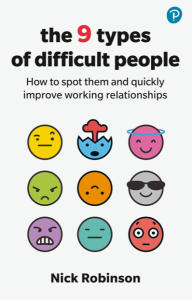 By Nick Robinson, left
By Nick Robinson, left
Maya Angelou wrote, “People will forget what you said, people will forget what you did, but people will never forget how you made them feel.”
One of the main reasons people leave a job is because of a bad manager. That’s going to hurt your business because:
- It costs money to replace them (up to twice the annual salary for executives)
- Lost income (one professional services firm estimated £100k in lost fees before they could replace a junior)
- Quality issues (51% of project failures are caused by a combination of poor communication by senior management and employee resistance)
- Disengaged employees can lead to up to 30% lower customer satisfaction.
If a leader who works for you is difficult, surely you’d already know?
Maybe… But some businesses are reluctant to risk making a bad situation worse. Especially because at the beginning you can’t tell just how difficult someone could get.
Others prefer to give people the benefit of the doubt. And some don’t act until they’re forced to by a crisis. It’s not always easy to know just what you can do to help a difficult leader. Remote working, wide spans of control and the pace of things can also hide what’s going on.
Warning signs
Here’s what to look out for:
- The Great Escape – staff, colleagues, and even customers are already leaving the business in significant numbers. Make sure you’re doing exit interviews.
- Bruised, Blocked or Burnt-Out – your own interactions with one specific person are leaving you feeling the pain.
- On Shaky Ground – you’ve got an uneasy feeling that gaps will open up or that critical issues aren’t being addressed.
- Closed and Toxic Culture – no matter how hard you try, there’s a whole unit delivering almost nothing positive, and often the leader tries to shut you out of it.
If there are signs of a difficult leader in your business, read on.
Ten Steps to Dealing with a Difficult Leader
1. Understand Why
A guiding principle that helps understand a difficult leader is Positive Intention. The idea that no matter how negative the results, people do things because – from their point of view – there was a good reason. This understanding helps to remove the heat and shows how to make a difference.
2. Fix What You Can
Fix these common issues that make some leaders become difficult:
- Conflicting Priorities – they’ve been tasked with doing something that conflicts with another major priority
- Lack of Resources – they genuinely don’t have what they need to do the job
- Insufficient Training – they’ve not had the leadership development it takes to navigate complex organisational dynamics.
3. Look for Patterns
Target your approach to dealing with a difficult leader by finding the patterns. It’s faster and more effective. For example, are they a Scary Specialist – an expert in their field who always lets people know it and sets demanding standards? Or perhaps they’re an Empire Builder – someone who grabs control so that no-one can criticise them?
4. Act Decisively
None of the businesses I’ve coached with has said they wished they’d put off dealing with a difficult leader. Do not let things fester, acting as soon as possible and making it clear that something needs to change.
5. Depersonalise Feedback
Leaders often become difficult because they’re afraid of something – failing, looking stupid, getting something wrong.
They may not consciously be aware of this fear, so use depersonalised feedback to avoid backing them into a corner. This focuses on the issue rather than the individual, ensuring the feedback is objective. For example:
- Instead of: “Michael tells me he hates working for you and has decided to quit.”
- Say: “Rates of staff turnover in the Commercial Department are twice as high as elsewhere in the business.”
6. Role Model
If you’re asking someone to change their behaviour, it’s crucial that you walk the talk. You don’t have to be perfect but you do have to commit to being at your best. For example, if you’re encouraging them to have open communication within their team, actively seek out and thoughtfully consider feedback on your own leadership style.
7. Set Clear Boundaries
Good fences make good neighbours. Define the way we do things around here – and what we don’t do. For example, ensuring that all communications, regardless of hierarchy, are conducted with respect and professionalism, explicitly discouraging any form of belittlement at work.
8. Focus on Outcomes
Keep your eye on the prize. What needs to be different, so that your business can be successful?
For example, if a difficult leader is micro-managing, help them understand what a more effective way of managing their team is. Perhaps saying, “I want you to experiment with setting clear objectives for your team and then let them achieve these goals in their own way, offering guidance only when needed.”
9. Support
Once you’ve set outcomes and boundaries, offer support. For example by asking, “What do you need from me or the business, to help make this possible?” And consider some external support for yourself and/or to help guide the development process.
10. Plan and Set Consequences
Set out a plan which agrees outcomes, timescales, and measures around what needs to change in this person’s behaviours. Include the consequences if that doesn’t happen. For example, a move to a more formal disciplinary process, or a revision to this person’s role.
Turn Challenge into Opportunity
The MD of a small technology business said to me about one difficult leader, “I just want my friend back.” The impact isn’t just felt by those who leave the business – it’s a pain for everyone.
It doesn’t have to be that way. SME’s can be great places to work. They build camaraderie, eliminate frustrating hierarchies, and directly link effort to outcomes. Get this right and it drives success and satisfaction. Which is exactly why taking constructive action is so crucial when faced with a difficult leader.
 Nick Robinson is the author of The 9 Types of Difficult People: How to spot them and quickly improve working relationships, out now, published by Pearson, priced at £14.99.
Nick Robinson is the author of The 9 Types of Difficult People: How to spot them and quickly improve working relationships, out now, published by Pearson, priced at £14.99.


